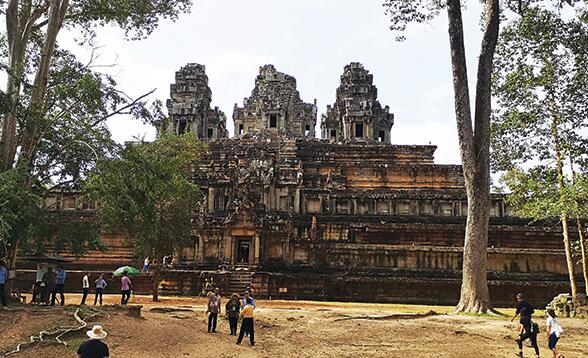Nation plays vital role in safeguarding and showcasing regional landmarks
China is playing a key role in protecting and displaying heritage, not only at home but also in the region.
For example, the country has partnered with Cambodia to preserve the ancient city of Angkor.
In an interview with Xinhua News Agency in January, Cambodian Minister of Culture and Fine Arts Phoeurng Sackona thanked the Chinese government for supporting her country in preserving its national heritage. She also expressed hope for skills exchanges through such collaboration.

The Ta Keo Temple at Angkor, Cambodia, built about 1,000 years ago, is one of the renovation projects China has become involved in protecting.[Photo provided to China Daily]
"We're confident in the abilities of Chinese experts, and through these projects, we hope that Cambodian experts will be capable of renovating temples by themselves in the future," Sackona said.
China became involved at Angkor after joining the International Coordinating Committee for the Safeguarding and Development of the Historic Site of Angkor, also known as ICCAngkor, an international campaign launched by Cambodia and UNESCO in 1993. It also funded years of excavation and renovation of the Ta Keo Temple at Angkor, which was built about 1,000 years ago.
China has no shortage of culturally significant landmarks and traditions. In January, the China Cultural Center in Yangon, capital of Myanmar, hosted a two-day exhibition of intangible cultural heritage from Yunnan province. The event showcased 16 intangible cultural heritage crafts - from bamboo weaving and tin-making techniques to woodcarving and making shadow puppets.
China ratified the 1972 World Heritage Convention in 1985 and has 53 properties inscribed on the UNESCO World Heritage List.
China is playing a key role in protecting and displaying heritage, not only at home but also in the region.
For example, the country has partnered with Cambodia to preserve the ancient city of Angkor.

The Ta Keo Temple at Angkor, Cambodia, built about 1,000 years ago, is one of the renovation projects China has become involved in protecting.[Photo provided to China Daily]
In an interview with Xinhua News Agency in January, Cambodian Minister of Culture and Fine Arts Phoeurng Sackona thanked the Chinese government for supporting her country in preserving its national heritage. She also expressed hope for skills exchanges through such collaboration.
"We're confident in the abilities of Chinese experts, and through these projects, we hope that Cambodian experts will be capable of renovating temples by themselves in the future," Sackona said.
China became involved at Angkor after joining the International Coordinating Committee for the Safeguarding and Development of the Historic Site of Angkor, also known as ICCAngkor, an international campaign launched by Cambodia and UNESCO in 1993. It also funded years of excavation and renovation of the Ta Keo Temple at Angkor, which was built about 1,000 years ago.
China has no shortage of culturally significant landmarks and traditions. In January, the China Cultural Center in Yangon, capital of Myanmar, hosted a two-day exhibition of intangible cultural heritage from Yunnan province. The event showcased 16 intangible cultural heritage crafts - from bamboo weaving and tin-making techniques to woodcarving and making shadow puppets.
China ratified the 1972 World Heritage Convention in 1985 and has 53 properties inscribed on the UNESCO World Heritage List.

